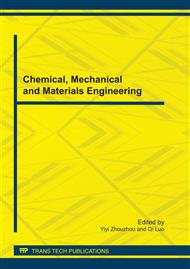p.53
p.59
p.65
p.71
p.77
p.83
p.87
p.93
p.99
Molten Slag Structure and Diffusion Coefficients of Cr3+ and Si4+ during Micro-Carbon Cr-Fe Alloy Production
Abstract:
Based on the silicate structure theory, the molten slag structure and the existential state of and during micro-carbon Cr-Fe alloy production process were analysised, and then their diffusion coefficients were calculated. The results showed that, during the initial stage, the average diffusion coeffecient of and is close to the , the reaction process is controlled by the diffusion of () and corporately, during the later stage, the diffusion coefficient of is less than average diffusion coefficient of and , the controlling step is the diffusion of . According to the evolution of diffusion coefficient, molten slag composition optimization method was advised to increase the diffusion ability of and for enhancing the reaction efficiency and the recovery rate of chromium.
Info:
Periodical:
Pages:
77-82
Citation:
Online since:
July 2011
Authors:
Price:
Сopyright:
© 2011 Trans Tech Publications Ltd. All Rights Reserved
Share:
Citation:


